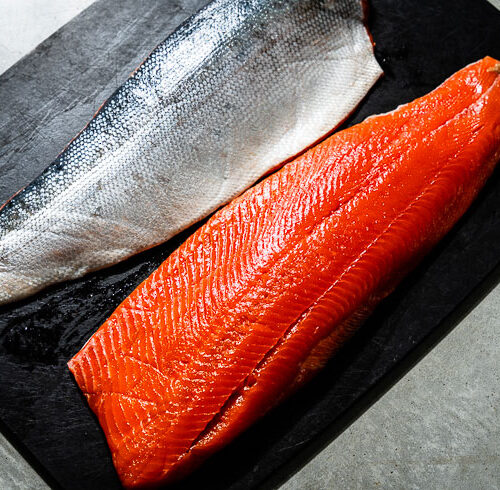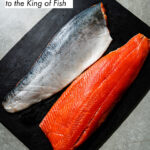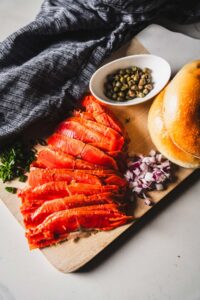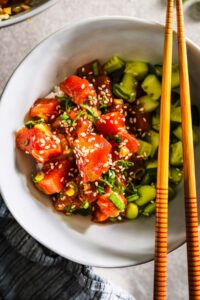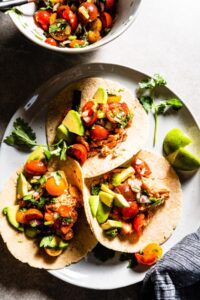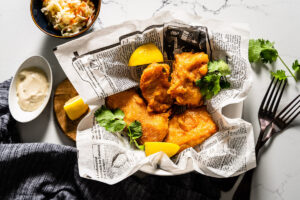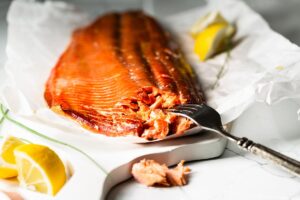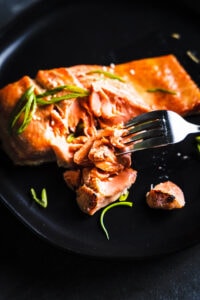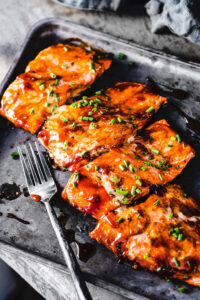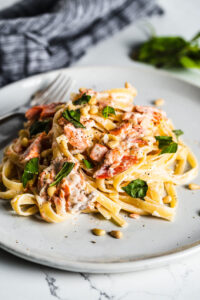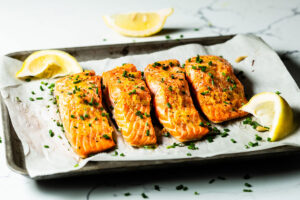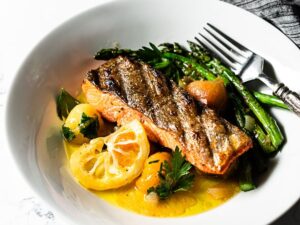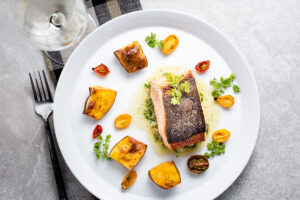A wild salmon is born hundreds of miles upstream, spends its life at sea and finds its way back to where it was born to start the cycle again. At every point along the way, the prolific fish provide food for eagles, otters, bears, people and even trees.
There are virtually endless ways to prepare salmon, from simply smoked using alder wood (which lines the banks of rivers in Alaska), to grilled with chimichurri, to adding it into a creamy lemon vodka pasta. The versatility of ways to enjoy salmon is almost endless, including cold-smoked and cured, or even raw in salmon poke or for sushi.
Since I have experienced Cordova, Alaska firsthand, I am a big proponent for Alaskan wild salmon, so that is what this guide will focus on.
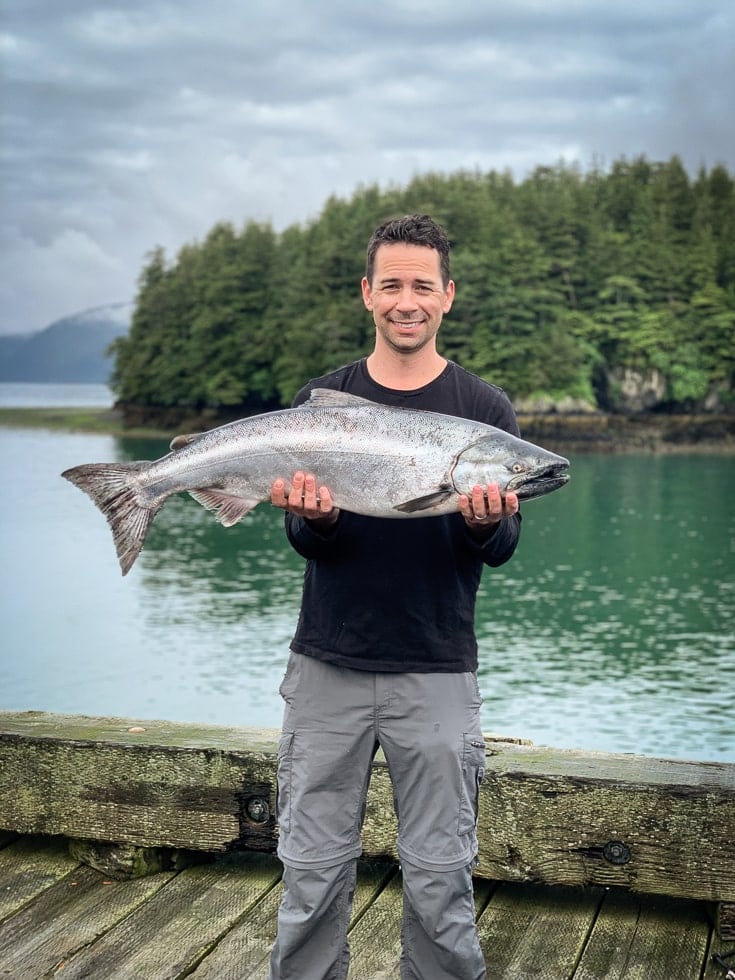
After catching my first wild salmon as a teenager in Monterey Bay, I was hooked. I can still remember cleaning and cooking that beautiful Califonia King that night. We had half of it smoked and the other half we cooked up in all different ways.
What Is Salmon?
Salmon are anadromous fish, meaning they spawn and develop in freshwater but spend most of their lives in the ocean. They are native to both the Atlantic (Atlantic salmon) and the Pacific (six different species, including chinook, coho and sockeye). They require high-quality habitat for reproduction, and therefore wild salmon stocks almost everywhere are in steep decline, with the notable exception of Alaska, where salmon management is exceptional.
Salmon have been culturally and commercially important since before recorded history, and the fish features in folklore from Scandinavia to Asia. With distinctively colored flesh — the result of carotenoids in a wild diet of krill and other tiny shellfish — salmon is high in protein, vitamins and beneficial fats.
Where Does Salmon Come From?
Salmon occur widely in the North Atlantic and throughout the Pacific, and they have been introduced successfully in many other places, including land-locked freshwater environments. Most salmon consumed in the US is farmed salmon, typically Atlantic salmon, grown in large ocean pens in places as diverse as Chile, Norway, Scotland and Canada. Wild-caught salmon are almost totally Pacific species (chinook, sockeye and coho).
Wild vs Farmed Salmon
Benefits of wild salmon — Wild-caught salmon usually has higher nutritional values. Buying wild salmon also supports fishermen and supports the habitats on which the fish depend.
Negatives of farmed salmon — The primary negative of farmed salmon is that as carnivorous fish, they require a high-protein diet typically comprising fish meal from wild-caught forage fish, which places a strain on these fish stocks at a time when most fisheries are already overfished; to produce one kg of farmed salmon typically requires two to four kgs of fish meal.
Farmed salmon are also typically higher in chemical contaminants like mercury. Other negative impacts include parasites, waste and other pollutants damaging the local marine environment, and the potential for escaped farmed salmon to interbreed with wild salmon, diluting the wild species.
With that being said, not all farmed salmon is bad. There is some sustainable and responsibly farmed salmon available.
Cooking Wild vs Farmed-Raised Salmon
There is a difference not only in how it tastes, but in how it looks and also how it cooks. It’s a little like thinking of how different a chicken is when it’s running wild, eating a natural diet, versus being confined to a cage its whole life, being fed grains and antibiotics. They live a different lifestyle and cook up differently.
Wild salmon is leaner and cooks more quickly. It is much less forgiving of overcooking. Farm-raised salmon is generally higher in fat and can be cooked to a higher temperature before it becomes dried out.
Knowing the difference in how wild and farm-raised salmon cooks is important because following a certain recipe might cause unexpected results.
This is a little like comparing a very lean filet mignon steak to a fatty ribeye. If you overcook the filet, it becomes dry and chewy. An overcooked ribeye will still be juicy, with just a slightly less desirable texture.
Cook farm-raised salmon to a higher temperature (around 125° F) and cook wild salmon to below that and you should be thrilled with the outcome.
When you have seen the amazing ecosystem of wild Alaskan salmon first-hand, there is no way you would ever want to settle for salmon that has been farmed in cages, dyed for color and injected with salt to keep it firm.
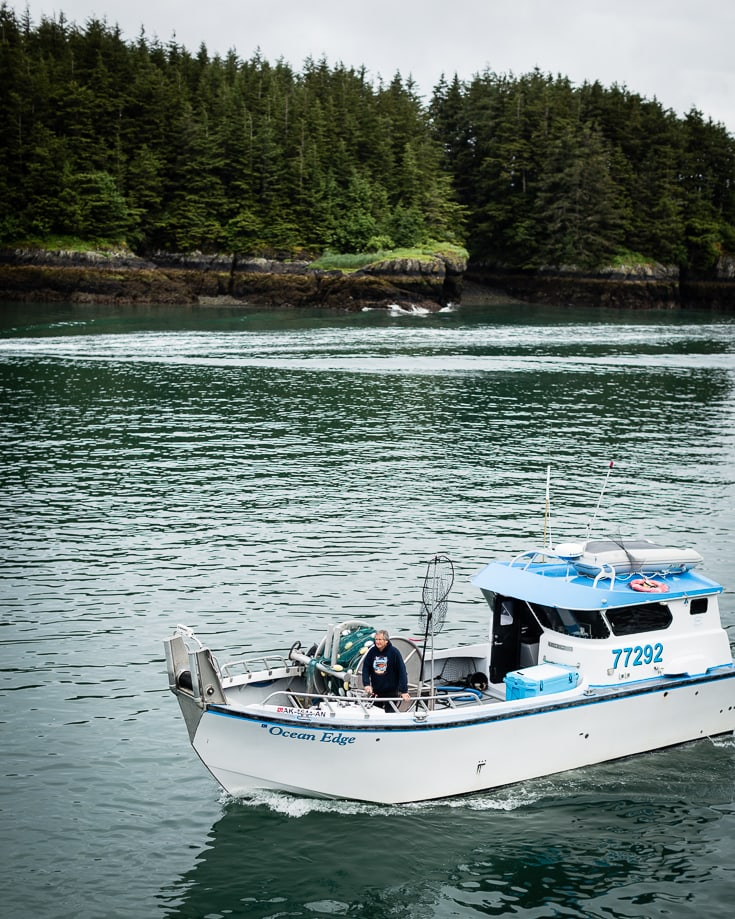
Types of Salmon
King Salmon (aka Chinook)
The largest of the Pacific species, king/chinook salmon range naturally from California to Alaska, and also in some parts of Asia. Outside of Alaska, wild populations are considered endangered, and chinook is only about 1% of the wild harvest. King salmon are also farmed in Chile and New Zealand (the New Zealand industry is considered sustainable). Often touted as the best-tasting salmon, with a rich, fatty flesh.
Sockeye
Also called red salmon, sockeye range from Oregon to the Arctic and Siberia. They are champions going upriver, with spawning populations in Idaho, 900 miles from (and 6,500 feet above) the Pacific. They make up about 20% of the wild harvest and are not usually farmed. The dark red flesh has a deep flavor.
Coho
Also called silver salmon, coho range from Monterey Bay to Hokkaido, Japan. Coho are about 5% of the wild catch. Similar in taste to Chinook, but with a more delicate texture.
Chum
The widest-ranging Pacific salmon, chum are also known as dog salmon or silverbrite. While they are about a third of the total wild salmon harvest, they are the least commercially valuable, and the paler, lean flesh is usually canned or frozen for overseas markets.
Pink
Also called, humpback salmon, pink salmon makes up over a third of the wild salmon catch. The flesh is light in color, flavor and fat content and is often canned or smoked.
Salmon Season / When Is Salmon in Season?
Wild salmon season is not all year long. In fact, it’s a fairly short season and depends on the species (and the Department of Fish and Game) as to when it is in season. Also, it’s not actually defined by calendar dates, but by when Fish and Game gives the word based on fish counts upstream.
King Salmon: May through June
Sockeye: May through July
Coho: August through September
Wild salmon is generally available fresh around these months; however, it is available frozen throughout the year. Freezing does not significantly degrade the texture of salmon.
How to Buy Salmon
Buying salmon usually starts with a few choices that might feel a little overwhelming at first. There will often be the option of wild or farmed, fresh or frozen, or even previously frozen and now thawed. You may also have a choice of species. Then there are the different cuts available. You can get a whole fish, a whole side (filet of half the fish), an individual filet or a steak cut of the fish.
As we talked about earlier, I always recommend wild salmon over farmed salmon whenever possible. Fresh is great, but if it’s not really fresh then fresh-frozen (aka frozen when it’s fresh) is better any day.
The important thing is that you get the highest quality fish that is the right cut for how you intend on utilizing it. Let’s get to the details.
Different Cuts of Salmon
When you are shopping for salmon, think about how you will use it. That determines which cut is best.
Whole Side
A whole side is like it sounds. It is one whole side of the fish. They are usually around 4 to 5 pounds (depending on the type of salmon) and can be cooked whole or portioned into individual filets. They are optimal for roasting and smoking.
A whole side is my preferred cut. It usually has the skin on and may still have the pin bones in place that will need to be removed.
Individual Filet
Individual filets are 4- to 8-ounce portions cut from the whole side. The skin is usually left on the filet and the pin bones may need to be removed. I like this cut if only a few portions are needed for a single meal. These are perfect for grilling or pan-searing.
Steak
A steak is a cross-section of the fish that includes a connected filet from each side. The spine and skin will still be on. These are best for pan-roasting or quick grilling. They aren’t my particular favorite, because all of the bones are left in the steak. While they are easily removed, it’s still something to deal with that some people might not love.
Fresh vs Frozen Salmon
Fresh salmon is better than frozen if it’s actually really fresh, which definitely isn’t always the case. It should smell like the sea and not super fishy. Fresh-frozen (flash-frozen soon after it was caught) will lock in the freshness and is better than non-fresh salmon any day.
Ask your fishmonger when the fish was caught and when they received it. If it’s more than 2 days, look for a flash-frozen option. This will taste much fresher.
Keep in mind that it’s best not to refreeze fish that has already been previously frozen. So plan accordingly.
How to Defrost Frozen Salmon
The best way to defrost vacuum-sealed salmon is by submerging it in a bowl of cold water in the refrigerator. This will defrost it pretty quickly and keeps the temperature of the salmon lower than defrosting on the counter, which keeps it fresher tasting.
If you need it defrosted more quickly, leave it out on the counter and refresh the water a few times until it is defrosted, usually in under 30 minutes. Be sure to refrigerate the salmon once it is defrosted if you don’t plan on using it right away.
How to Store Salmon
Once you bring your beautiful salmon home, it’s so important to store it right for optimal enjoyment.
Fresh salmon should be stored very cold. When you bring it home, place it in plastic bags and then on top of a bowl of ice in the coldest area of your refrigerator. This super cold environment will give you a few days of keeping that salmon as fresh as possible.
If the fresh salmon won’t be consumed within 2 days, it is recommended to freeze it (see below).
How to Freeze Salmon
To maintain peak freshness, freeze the salmon as soon as possible, so it stays as fresh-tasting as possible. Vacuum sealing is the optimal way to do this as air against the fish is the enemy in the freezer. Write the date and contents on the bag with a Sharpie before putting it in the bag.
Portion the filets, pat dry with a paper towel, vacuum seal and place in the freezer.
If you bring home a whole side, cut off what you need and freeze the rest in individual portions to take out later. I don’t recommend refreezing salmon that has previously been frozen.
If you don’t have a vacuum sealer (affiliate), you can use Ziploc freezer bags and remove all the air using the water displacement method.
Prepping Salmon
Remove Those Pin Bones
First things first is to pluck the pin bones that are present in the middle of the filet running lengthwise. Feel with your hands and use a good pair of fish bone tweezers to pluck all of them out. You can even drape the filet over the back of a medium-size bowl, which will make the bones stick out and easy to grab with the tweezers.
Skin On / Skin Off?
Is that really a question? Crispy salmon skin is amazingly tasty. However, if the skin isn’t your thing, it can be removed either before or after cooking. If you don’t have a sharp filet knife, it is easier to remove after by just sliding a spatula between the flesh and the skin.
Scale It
If you plan on eating the skin and the scales were left on, then you will want to remove the scales even though it is technically fine to eat them. Use the back of a knife to scrape the scales against the grain to remove and discard the scales. It’s much easier to do this for a whole side rather than individual filets.
Trim It
Optional, but great for presentation. Use a very sharp knife to trim off the very edges of the filet (about 1/4″) to clean it up. This is totally optional and more about presentation. The thin part of the belly can also be trimmed off.
The tail end is thinner and narrower than the rest of the filet. You can trim the thinner tail end off and cook it separately (as it will cook faster), or you can fold it over when cooking the whole filet to get a more even cook.
If you have little scraps leftover, don’t throw them away. They are super nutritious and can be incorporated into your dog’s food. I will cook them up, but some people feed them raw (I’m not a pet food expert).
Cut the Filets
If you will be pan-searing or grilling and are starting with a whole side, then you will want to slice it into individual equal size filet portions. Keeping the sizes uniform are really important for consistent cooking.
Where to Buy Salmon
While salmon of some type is available at almost every grocery store, high-quality salmon can be a little more difficult to find. It’s important to buy from a reputable source to make sure you are actually getting what they say you are getting.
Local Fish Markets: Local fish markets are my favorite place to buy fresh seafood, but buying salmon there means you probably live on the West Coast of North America, and most likely above Oregon since that is where they are caught.
If a market outside of that region is selling salmon, it’s likely not local, which might be just fine as long as it’s high-quality and fresh.
Online: Buying salmon online is sometimes the best way, as it is flown all over the country and can be very fresh. You can use the Copper River Salmon Where to Buy tool to find places to buy Alaskan salmon. Crowd Cow (affiliate) is also a wonderful online supplier of wild salmon.
Grocery and Wholesale Stores: Whole Foods is known to get fresh salmon flown in very frequently. Costco has fresh wild salmon when it’s in season and frozen when it’s not (and farm-raised throughout the year) with some of the best prices you will find anywhere.
Temperatures for Cooked Salmon
The finished internal temperature of 120 to 130 degrees F is optimal.
Like a steak, salmon can be cooked to different temperatures depending on your preference. Cooking it to medium is usually optimal. Overcooking beyond that will result in salmon that can become dry. Wild salmon should be cooked less than farmed (you can even cook it to 120 degrees F) as it is leaner.
Always cook to temperature, rather than by time.
How to Tell if Salmon Is Cooked
There are three main ways to tell if salmon is cooked to the desired temperature. Cooking by time is never the best way to tell if the fish is cooked all the way through as there are so many variables, including filet size, starting temperature, oven temperature and more.
- Instant-read probe thermometer: This is the best and most accurate way to tell if salmon is perfectly cooked.
- Feel: Gently press down on the filet. If it just barely starts to flake, it’s done.
- If albumin (harmless white goop) starts to appear on the top and sides, it’s definitely time to take it off the heat before it’s too late.
When you have cooked salmon a few times, you start to get a really good feel for how it looks and feels when it is perfectly cooked.
Reheating Cooked Salmon
The first answer is: Don’t reheat cooked salmon. Cold salmon is almost as delicious as it is warm. If the salmon is cooked rare the first time, it usually does well for a reheat. But it can easily overcook if it was already on the brink.
But if you must. Reheating it in the microwave is not a good option. You will want to cover it with foil and heat it up really slowly in a low (275 to 300 degree F) oven until it is warmed through to 125 degrees.
Top Tips & Rules for Salmon
- Don’t overcook your beautiful salmon.
- Buy wild if possible.
- Buy fresh if it’s really fresh; buy fresh-frozen when it’s not.
- Keep it fresh by storing it correctly.
- Cook by temperature and not by time.
Essential Tools & Equipment
- Flexible filet knife
- Fish bone tweezers to remove the pin bones
- Fish scaler to remove the scales from the skin
- Fish spatula
- Carbon steel searing Skillet
- Thermapen instant-read probe thermometer
- Vacuum sealer + bags for freezing

